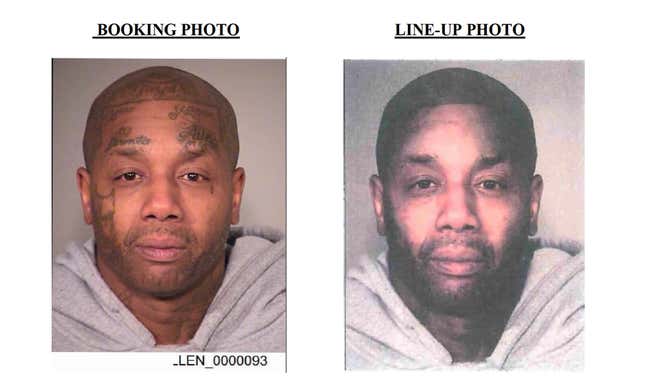
I know they think we all look alike, but with the assortment of distinct tattoos that adorn Tyrone Lamont Allen’s right cheek, forehead and left eye, it’s pretty damn hard to mistake the 50-year-old for anybody else. Yet, when a string of bank heists occurred in April 2017 and not a single bank teller could recall seeing any tattoos on the face of the suspect who robbed them, Portland police did the unthinkable, according to Oregon Live.
“I basically painted over the tattoos,” police forensic criminalist Mark Weber testified . “Almost like applying electronic makeup.’’
Specifically, Portland police digitally altered Allen’s mugshot by using Photoshop to remove his tattoos entirely. Then, without telling anyone that they altered his photo, they presented his new mugshot along with photos of “five similar-looking men” to the bank tellers for identification. And as you suspected, some of those tellers then identified Allen as the culprit.
If you’re sitting there disgusted that the police would go to such brazen lengths to implicate a suspect, you wouldn’t be alone. Jules Epstein, a law professor at Temple University, who Oregon Live describes as “one of the leading national authorities on eye witness testimony,” said that in his 40 years of practicing law he’s never heard of anything so “blatantly suggestive.”
“It’s unbelievable to me that police would ignore the fact that no teller has described a person with glaring tattoos and make this man into a possible suspect by covering them up,” he said. “They’re increasing the risk of mistaken identity.’’
According to the Innocence Project, mistaken identity has contributed to approximately 71 percent of the more than 360 wrongful convictions in the United States overturned by post-conviction DNA evidence. As a result, this glaring weakness in the criminal justice system is long overdue for a complete overhaul.
Allen is currently facing three counts of robbery and one count of attempted robbery, all related to the string of bank heists in April 2017, and U.S. District Judge Marco A. Hernandez will soon decide if Allen’s rights were violated and if the related evidence will be admissible in court.
In the interim, notable figures such as Marc Lamont Hill have taken to social media to express their disgust at what they believe to be a grave injustice.
“THIS IS OUTRAGEOUS!!!” Hill wrote on Instagram. “The media is framing this as a question of whether the police methods were constitutional. Let’s be clear: this man was framed and is being railroaded. These are the everyday forms of injustice that continue to swell the prisons and end lives. We must fight back!!!”
From Oregon Live:
How U.S. District Judge Marco A. Hernandez rules in this case could set precedent on police practices for future cases in Oregon and beyond, though it may ultimately end up before an appellate court, said Steve Kanter, a retired law professor and dean emeritus at Lewis & Clark Law School.
“The touchstone is trying to have the most reliable procedure so you reduce the likelihood or risk of error,’’ Kanter said.